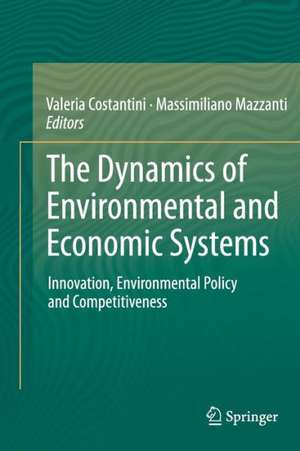The Dynamics of Environmental and Economic Systems: Innovation, Environmental Policy and Competitiveness
Editat de Valeria Costantini, Massimiliano Mazzantien Limba Engleză Paperback – 9 noi 2014
| Toate formatele și edițiile | Preț | Express |
|---|---|---|
| Paperback (1) | 557.21 lei 39-44 zile | |
| SPRINGER NETHERLANDS – 9 noi 2014 | 557.21 lei 39-44 zile | |
| Hardback (1) | 567.88 lei 39-44 zile | |
| SPRINGER NETHERLANDS – 31 oct 2012 | 567.88 lei 39-44 zile |
Preț: 557.21 lei
Preț vechi: 696.52 lei
-20% Nou
Puncte Express: 836
Preț estimativ în valută:
106.63€ • 114.02$ • 88.90£
106.63€ • 114.02$ • 88.90£
Carte tipărită la comandă
Livrare economică 14-19 aprilie
Preluare comenzi: 021 569.72.76
Specificații
ISBN-13: 9789401783552
ISBN-10: 9401783551
Pagini: 256
Ilustrații: XXII, 234 p.
Dimensiuni: 155 x 235 x 13 mm
Greutate: 0.36 kg
Ediția:2013
Editura: SPRINGER NETHERLANDS
Colecția Springer
Locul publicării:Dordrecht, Netherlands
ISBN-10: 9401783551
Pagini: 256
Ilustrații: XXII, 234 p.
Dimensiuni: 155 x 235 x 13 mm
Greutate: 0.36 kg
Ediția:2013
Editura: SPRINGER NETHERLANDS
Colecția Springer
Locul publicării:Dordrecht, Netherlands
Public țintă
ResearchCuprins
Introduction.- PART I Modelling Macroeconomic Scenarios: Energy Issues, Economic Performances and Environmental Policy.- Chapter 1 The GTAP-E: Model Description and Improvements.- Chapter 2 Carbon Leakage and Trade Adjustment Policies.- Chapter 3 Theoretical Approaches to Dynamic Efficiency in Policy Contexts. The Case of Renewable Electricity.- Chapter 4 Energy Efficiency Policy in the US: The Impact of the Industrial Assessment Centres (IAC) Programme and State and Regional Climate Policy Actions.- Chapter 5 Porter Reloaded: The Role and Effectiveness of Environmental and Social Regulations for Realizing Innovation offsets and Enhancing Firm Competitiveness.- PART II Environmental Innovation and Competitiveness: Linking Micro, Meso and Macro Analysis in the Dynamics.- Chapter 6 Implications of Policy Uncertainty for Innovation in Environmental Technologies. The Case of Public R&D Budgets.- Chapter 7 Eco-Activity and Innovativeness: What is Their Relation to Environmental Performance in Consumer Firms and Industrial Firms? .- Chapter 8 Environmental Policy and Induced Technological Change in European Industries.- Chapter 9 Closing the Gap? Dynamic Analyses of Emission Efficiency and Sector Productivity in Europe.- Chapter 10 Waste Technology Inventions and Policy Effects in Dynamic Settings. Evidence from OECD Patent Data.- Chapter 11 Biopat: An Investigation Tool for Analysis of Industry Evolution, Technological Paths and Policy Impact in the Biofuels Sector.- Index.
Textul de pe ultima copertă
This book looks for responses to the need for more complex dynamic reasoning in environmental economics by developing a series of both theoretical and empirical integrated approaches. The quartet of core and interlinked issues addressed are central to the requirements of policy makers and scholars who require robust methodologies for assessing the role played by innovation and environmental policy in determining economic performance. The volume examines the potential alternative uses of recently available hybrid economic-environmental accounting at meso-level, both for ex-ante and ex-post analysis. It studies the deployment of dynamics to explain the co-evolution of economic and environmental systems. The authors also explore how technological innovation drives sustainability goals, and demonstrate the importance of working at sector level rather than at aggregated national level.
Exploiting econometric techniques aimed at dealing with the dynamics of economic systems andthe heterogeneity of agents performances, the volume integrates innovation-based reasoning with ex-post analyses, and presents ex-ante analyses able to evaluate the role of climate change policies by using computable general equilibrium models such as the Global Trade Analysis Project for Energy (GTAP-E). The authors merge and use a range of datasets, including OECD-PATSTAT and STAN, to test novel techniques informed by evolutionary economic theories and the Porter hypothesis. The immediate relevance and applicability of the models will strengthen the hand of policy analysts for whom the dynamic efficiency of environmental policy is a new, high-profile evaluation criterion.
Exploiting econometric techniques aimed at dealing with the dynamics of economic systems andthe heterogeneity of agents performances, the volume integrates innovation-based reasoning with ex-post analyses, and presents ex-ante analyses able to evaluate the role of climate change policies by using computable general equilibrium models such as the Global Trade Analysis Project for Energy (GTAP-E). The authors merge and use a range of datasets, including OECD-PATSTAT and STAN, to test novel techniques informed by evolutionary economic theories and the Porter hypothesis. The immediate relevance and applicability of the models will strengthen the hand of policy analysts for whom the dynamic efficiency of environmental policy is a new, high-profile evaluation criterion.
Caracteristici
Compelling, integrated new research material by leading scholars in the field Multi-perspective analyses of dynamic economic-environmental issues Suggestions for policy makers, managers and research scholars A vital addition to postgraduate and PhD students reading lists Includes supplementary material: sn.pub/extras













